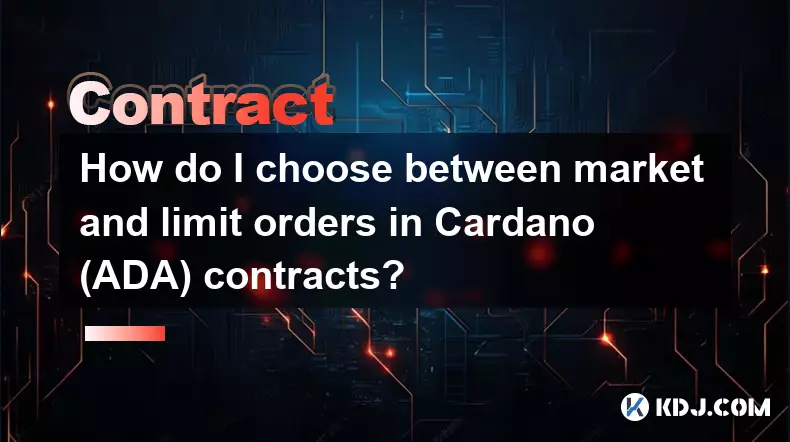-
 bitcoin
bitcoin $122288.232522 USD
0.16% -
 ethereum
ethereum $4480.662914 USD
-0.22% -
 xrp
xrp $2.962747 USD
-2.32% -
 tether
tether $1.000120 USD
-0.05% -
 bnb
bnb $1145.654223 USD
-2.07% -
 solana
solana $227.105217 USD
-1.67% -
 usd-coin
usd-coin $0.999548 USD
-0.02% -
 dogecoin
dogecoin $0.250875 USD
-2.04% -
 tron
tron $0.340654 USD
-0.49% -
 cardano
cardano $0.837968 USD
-2.52% -
 hyperliquid
hyperliquid $48.960449 USD
0.06% -
 chainlink
chainlink $22.049280 USD
-1.33% -
 ethena-usde
ethena-usde $1.000404 USD
0.02% -
 sui
sui $3.586212 USD
0.20% -
 avalanche
avalanche $29.894916 USD
-4.18%
How do I choose between market and limit orders in Cardano (ADA) contracts?
Market orders on Cardano DEXs enable instant ADA trades at best available prices, ideal for speed, while limit orders offer price control, crucial for risk management in volatile markets.
Sep 29, 2025 at 12:00 am

Understanding Market Orders in Cardano (ADA) Contracts
1. Market orders allow traders to execute trades immediately at the best available price on the exchange. When engaging with Cardano-based smart contracts or decentralized exchanges (DEXs) that support ADA, using a market order ensures speed and execution certainty. This is particularly useful during periods of high volatility when price movements are rapid and missing an entry or exit point could lead to significant opportunity cost.
2. The primary advantage of a market order lies in its immediacy. For users interacting with DeFi protocols built on the Cardano blockchain, such as SundaeSwap or Minswap, executing a trade instantly can be crucial. If a user needs to liquidate a position quickly due to shifting market sentiment or contract conditions, a market order removes uncertainty about whether the trade will go through.
3. However, market orders come with the risk of slippage, especially in low-liquidity pools. Since Cardano’s DEX ecosystem is still maturing compared to Ethereum’s, some trading pairs may not have deep enough order books. This means that large market buy or sell orders can significantly impact the executed price, resulting in less favorable outcomes than anticipated.
4. Gas fees on Cardano are generally lower than on other blockchains, but using a market order within a congested network moment—though rare—can still lead to slightly higher transaction costs if multiple attempts are needed due to failed swaps. Smart contract interactions require confirmation, and market orders tied to automated strategies must account for finality delays.
Advantages of Limit Orders for ADA Trading
1. A limit order allows a trader to set a specific price at which they are willing to buy or sell ADA within a smart contract environment. This provides greater control over entry and exit points, which is essential when managing risk in volatile crypto markets. On Cardano-native platforms like WingRiders, limit orders are supported and enable precision in trade execution.
2. By defining a maximum purchase price or minimum sale price, traders protect themselves from adverse price swings. For example, placing a limit buy order below the current market price can help accumulate ADA during temporary dips without constant monitoring. This strategy aligns well with algorithmic trading bots operating on-chain via Plutus scripts.
3. Limit orders contribute to market depth by adding liquidity to order books. In decentralized finance ecosystems hosted on Cardano, users who place limit orders effectively act as passive liquidity providers until their conditions are met. This strengthens the overall stability and efficiency of peer-to-peer trading mechanisms.
4. One drawback is that limit orders are not guaranteed to execute. If the market never reaches the specified price, the trade remains unfilled. In fast-moving scenarios—such as after major Cardano upgrades or partnership announcements—this could mean missed opportunities despite having a sound strategy.
Matching Order Types to Contract Use Cases
1. When interacting with yield farming contracts on Cardano, timing may matter less than price accuracy. Depositing ADA into a liquidity pool at a favorable rate often justifies using a limit order to avoid overpaying during short-term spikes. Precision here directly affects long-term returns and impermanent loss exposure.
2. For arbitrage bots running on Cardano’s multi-asset ledger, market orders are typically preferred due to the need for split-second execution across different DEXs. Even with slippage risks, the profit margins in arbitrage rely on speed, making immediate fill priority over optimal pricing.
3. During initial project launches on Cardano launchpads, where tokens are distributed via smart contracts, participants might use market orders to ensure participation before allocation caps are reached. Waiting for a limit condition could result in complete exclusion from the offering.
4. Stop-loss mechanisms implemented through third-party services or future scriptable triggers may combine both order types: a stop-market order to exit rapidly once a threshold is breached, or a stop-limit to maintain price control during turbulent exits.
Frequently Asked Questions
What determines slippage tolerance when placing a market order for ADA?Slippage tolerance is set by the user in most DEX interfaces and defines the maximum price deviation acceptable for a trade. On Cardano platforms, typical default settings range between 0.5% and 1%, but volatile conditions may require adjustment to prevent failed transactions.
Can limit orders be used in Cardano NFT sales governed by smart contracts?Yes, certain Cardano NFT marketplaces integrate limit-order logic through escrow-style contracts. Buyers can submit offers denominated in ADA, which sellers can accept later, creating a form of off-chain limit intent validated on-chain upon agreement.
Do all Cardano DEXs support both market and limit orders?No, not all decentralized exchanges on Cardano offer full order book functionality. Some use automated market maker (AMM) models where only market-like swaps occur, while others like WingRiders implement hybrid systems supporting true limit orders.
Disclaimer:info@kdj.com
The information provided is not trading advice. kdj.com does not assume any responsibility for any investments made based on the information provided in this article. Cryptocurrencies are highly volatile and it is highly recommended that you invest with caution after thorough research!
If you believe that the content used on this website infringes your copyright, please contact us immediately (info@kdj.com) and we will delete it promptly.
- BlockDAG, DOGE, HYPE Sponsorship: Crypto Trends Shaping 2025
- 2025-10-01 00:25:13
- Deutsche Börse and Circle: A StableCoin Adoption Powerhouse in Europe
- 2025-10-01 00:25:13
- BlockDAG's Presale Buzz: Is It the Crypto to Watch in October 2025?
- 2025-10-01 00:30:13
- Bitcoin, Crypto, and IQ: When Genius Meets Digital Gold?
- 2025-10-01 00:30:13
- Stablecoins, American Innovation, and Wallet Tokens: The Next Frontier
- 2025-10-01 00:35:12
- NBU, Coins, and Crypto in Ukraine: A New Yorker's Take
- 2025-10-01 00:45:14
Related knowledge

What is the difference between futures and perpetual contracts for Bitcoin?
Oct 02,2025 at 11:54pm
Understanding Bitcoin Futures Contracts1. Bitcoin futures are derivative instruments that allow traders to speculate on the future price of Bitcoin at...

What is the best time to trade PEPE contracts?
Oct 03,2025 at 11:54am
Understanding PEPE Contract Volatility1. PEPE contracts exhibit extreme price fluctuations due to their meme-based nature and low market cap. Trading ...

What are the common mistakes to avoid with Bitcoincoin contracts?
Oct 03,2025 at 08:54am
Emerging Trends in the Cryptocurrency Market1. Decentralized finance (DeFi) platforms continue to expand their influence across the blockchain ecosyst...

What is the maintenance margin for Bitcoin contracts?
Oct 02,2025 at 01:36am
Decentralized Exchanges Gain Momentum in 20241. Decentralized exchanges (DEXs) have seen a significant rise in trading volume, surpassing centralized ...

How to use technical analysis for trading XRP contracts?
Oct 03,2025 at 01:18pm
Understanding Price Patterns in XRP Futures1. Identifying chart patterns such as triangles, head and shoulders, and double tops or bottoms can provide...

What does "longing" PEPE contracts mean?
Oct 03,2025 at 11:54pm
Understanding Decentralized Exchanges in the Crypto Ecosystem1. Decentralized exchanges (DEXs) operate without a central authority, allowing users to ...

What is the difference between futures and perpetual contracts for Bitcoin?
Oct 02,2025 at 11:54pm
Understanding Bitcoin Futures Contracts1. Bitcoin futures are derivative instruments that allow traders to speculate on the future price of Bitcoin at...

What is the best time to trade PEPE contracts?
Oct 03,2025 at 11:54am
Understanding PEPE Contract Volatility1. PEPE contracts exhibit extreme price fluctuations due to their meme-based nature and low market cap. Trading ...

What are the common mistakes to avoid with Bitcoincoin contracts?
Oct 03,2025 at 08:54am
Emerging Trends in the Cryptocurrency Market1. Decentralized finance (DeFi) platforms continue to expand their influence across the blockchain ecosyst...

What is the maintenance margin for Bitcoin contracts?
Oct 02,2025 at 01:36am
Decentralized Exchanges Gain Momentum in 20241. Decentralized exchanges (DEXs) have seen a significant rise in trading volume, surpassing centralized ...

How to use technical analysis for trading XRP contracts?
Oct 03,2025 at 01:18pm
Understanding Price Patterns in XRP Futures1. Identifying chart patterns such as triangles, head and shoulders, and double tops or bottoms can provide...

What does "longing" PEPE contracts mean?
Oct 03,2025 at 11:54pm
Understanding Decentralized Exchanges in the Crypto Ecosystem1. Decentralized exchanges (DEXs) operate without a central authority, allowing users to ...
See all articles










































































